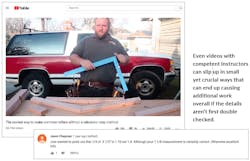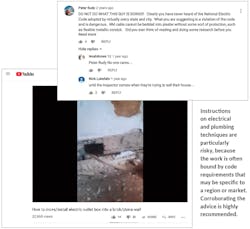Next, Do This
Peters is one of countless craftsmen who’ve taken to social platforms to share the jobsite know-how they’ve collected over the years; and in his case, over the decades, having started as a cabinet maker at the age of 17. (He’s now 51.)
“I think anyone who builds something they’re proud of wants to show someone,” says Peters.
A decade ago, a carpenter (or other trade professional) would go to books for their crafting tips. Today it’s YouTube (and increasingly Instagram). “If I don’t know how to do something, I’m going to the internet,” says Chicago carpenter Jon Garcia. “It’s too quick and too easy. And there’s a ton of quality stuff available.”
Posting how-to content on social media can be personally satisfying and lucrative. But, in order to do it right, there’s a few things to keep in mind.
(Assumed) Quality Issues
Is there truly a ton of quality stuff out there? Think of social media, where anyone can post videos, and apart from looking for vulgarity and hate, there isn’t much formal policing of quality being conducted by the platforms. Mark Donovan, an electrical engineer who runs the YouTube channel HomeAdditionPlus, a 14-year-old brand with 31,000 subscribers and more than 29 million views, says that he’s rarely spoken to the platform about quality. “The talks were about branding and having smarter keyword choices,” he says.
Considering the context, inaccurate content seems an inevitability. And in a way, it is.
We found several examples of inaccurate content in preparation for this story: instructions for making rafters with bad math; a flooring demonstration that featured very uneven nail spacing; and an electric outlet install showing an NM wire being bedded into plaster without a raceway (i.e., a code violation). Those were expected, though, and so weren’t surprising to find.
The real surprise, at least to us, was that there wasn’t more; however, Dan Morrison, editor of ProTradeCraft.com, a nexus for instructional content (and Pro Remodeler’s sister site), said that was to be expected.
“People were posting a lot of poor content early on, but I’m not coming across much these days,” he says. It’s carpentry videos he sees the most, and it’s the trade’s rich tradition that keeps quality obvious. “You think of carpentry, and the basics haven’t changed for a couple hundred years—crown molding is still crown molding, trimming a door is still trimming a door.”
Garcia, our carpenter out of Chicago and a self-proclaimed devourer of instructional content from both YouTube and Instagram, certainly believes he can spot a shoddy video. “If the mistakes aren’t pointed out in the comments, the work ends up giving it away.”
In a study coming out of the University of California’s School of Information and Computer Sciences, researcher Christine Wolf found that when it came to how-to home repair videos on YouTube, viewers considered the task of determining credibility near trivial because it was so avoidable, with many explaining it as a matter of “you can just tell.” One subject Wolf interviewed claimed, “I watch the YouTube video of someone doing something, and I can tell if they’re doing a good job or not ... You can see as they’re doing it if anything would cause a problem. You can see when they’re done with it that it works and everything.”
With the abundance of content, the good stuff seems to get pushed up in the search results, while the bad stuff seems to get lost (and ultimately forgotten) in the noise. This Old House, one of the industry’s most storied and trusted how-to video providers, doesn’t even consider competitive content when posting online, because as executive producer Chris Wolfe says, “We keep an educational mission, and so we simply present our content in a way that’s accurate and we think will be most helpful to our viewers.”
Still, good videos with small (though potentially disruptive) mistakes make it through the all the time. Our bad-math rafter instructional had more than 55,000 views. And because of that, Morrison suggests three credibility checks for anyone looking at how-to remodeling videos:
1] Cross-reference with trusted sources, including websites like ProTradeCraft and more experienced craftsmen.
2] Know your building codes.
3] Understand energy codes, especially as not everyone posting videos is up-to-date with the many recent changes.
As a business owner, if inaccurate how-to references are a serious concern, the safest remedy is to post your own.
Making Money as an Authority
If you’re not a remodeler looking for instruction, you may be one in the position to give it. And not only does that come with the perk of further cultivating your “authority” air, but it gives you the option to potentially monetize your contributions. That’s certainly what electrical engineer Mark Donovan did.
“I started HomeAdditionPlus.com in 2005, and started posting videos under the banner in 2007,” he says. “Four years later, I was making about five grand a month from it. About 40% of HomeAdditionPlus’ revenue comes from YouTube videos.”
Donovan only posts part-time, and his work almost always involves just one guy with a camera. It’s the same with Jon Peters, despite having more subscribers than The Home Depot. Both say that the monetizing aspect of YouTube is done with very little effort.
“Everyone on YouTube that monetizes gets revenue from Google,” Peters says. Because Google owns YouTube, it has, in very Google fashion, streamlined the process so that everything goes through it. “The earned amount is based on views and engagement.”
To monetize a channel is easy: You create the channel, join the YouTube Partner Program, and then simply turn on the monetization feature (found in the YouTube Creator Studio under “Channel,” and then “Status and features”). To become a YouTube Partner is a bit more challenging, as it requires 4,000 public watch hours in the last 12 months and at least 1,000 subscribers. But once you reach that threshold, you link your Google AdSense account with your channel, and the money starts rolling (or trickling) in. Donovan says that in recent years, with increased competition from everyday remodelers and big-box hardware stores, like Lowes and The Home Depot (who, combined, have about 1 million subscribers), ad returns have dipped dramatically. “I’m now making closer to $1,000 a month.”
On Instagram, the road to revenue is less obvious, because it’s less trodden. There is no quick-and-easy “monetization” switch to flip on. “YouTube is more interactive than Instagram, so currently it’s easier to make money there, but more and more I find myself consuming Instagram content,” says Peters, who’s building up his Instagram in hopes of more successfully monetizing it. “The ability to tag and swipe up to content or to another content creator is very valuable to potential advertisers.”
This Old House is also increasing its Instagram presence, hoping to capitalize on the platform’s growing prevalence among craftsmen. “We are building up our presence on all the channels available to interested viewers.”
Making Money as an Advertisement
One of the ways people are finding to make money on Instagram is through product placement—something that manufacturers have long been participating in on YouTube, even if you never noticed.
In his busiest years, 2011 and 2012, Donovan says that HomeAdditionPlus was targeted heavily by major tool brands. “They were hoping for product reviews, but there were a few cases of product placement that made me some extra revenue.”
A deck builder out of Seattle named Jason Russell goes by Dr. Decks on Instagram, where he has just over 80,000 followers. He produces revenue (though he can’t disclose how much) from brand partnerships with Regal Ideas, which manufactures aluminum railing systems, and LED outdoor lighting producer in-lite. He represents those brands, he says, as a brand ambassador.
Peters has taken a similar approach, partnering with brands as a way to further monetize both his Instagram and YouTube channels, though he doesn’t serve as an official brand ambassador. His agreements have been specifically for product placement in videos.
It’s a great way to make extra money and get free product, both Russell and Peters agree. However, as ProTradeCraft’s Morrison will tell you, the trend among non-journalist content producers getting into product placement should come with a disclaimer.
“A lot of the guys making it big on Instagram and YouTube, they’re not used to big companies asking them for things, and they’re especially not used to toeing that line between ethical journalism and what might be seen as ‘pay to play’ advertising,” Morrison says. “If you’re a content producer who becomes too intertwined with a product, it’s likely to eventually erode your credibility.”
If the mistakes aren’t pointed out in the comments, the work ends up giving it away
Russell tags himself as a brand ambassador on his Instagram, and Peters says that he only indulges in product placement when it’s a product he’s used enough to trust. “Before I started including the zero-G hose in videos, I used it for a while to make sure it was something I would recommend,” Peters says. “I always want to feel comfortable with what I’m promoting.”
Even faced with those facts, Morrison still warns content producers—especially remodelers turned online instructors whose channels will live and die by their credibility—that too much product placement will hinder their watchability factor, and ultimately their value to potential advertisers. The good news is a 2016 study from Defy found that: 1. Nearly two-thirds of Millennials, who notoriously hate ads, don’t mind watching them if it means supporting their favorite online personalities, who they know survive on ad dollars; and 2. Eighty-seven percent of Millennials are fine with product placement, so long as it’s informative and the sponsorship is made apparent. The takeaway for remodelers? Don’t try to be sly about your product placement.
Practical Benefits
Both YouTube and Instagram are undeniably popular platforms, each attracting 1 billion visitors monthly (closer to 2 billion for YouTube)—visitors that represent a diverse demographic makeup. In a 2,000-person survey conducted by communications company We Are Flint (WAF), it was found that YouTube cuts across virtually all age ranges. It’s the No. 1 most used app among people aged 18 to 34, and the No. 2 most used for people aged 35 and up.
Instagram tilts younger, with most of its users being aged 18 to 34. Still, the platform is growing quickly. From 2016 to 2018, the share of adults using Instagram jumped from 29% to 41%.
The reason advertisers want in on YouTube and Instagram is the same reason remodelers should: reach. These platforms reach prime audiences in every part of the country—urban and rural—and in every economic class. Rich and poor alike are on YouTube and Instagram, just as rich and poor alike want home improvements, and sometimes need home repairs.
“Instagram is my portfolio,” says Jason Russell, a.k.a. Dr. Decks. “I can send anyone with a phone to my Instagram and they can go deep into it.”
Through instructional content, remodelers can engage with an audience they already know is interested in the material, giving them valuable information as well as a call to action. “For more information visit …” or “Tell us what you think in the comments below”—prompts give people a reason to go to a website or start a conversation, both of which can be good for business and authority.
As much as anything, content is marketing material—whether it’s a snapshot of a finished deck, or a short video explaining how to build deep stair jacks, they both affirm confidence in a business’s competence. In an industry where the experts are called craftsmen, that confidence is invaluable.






